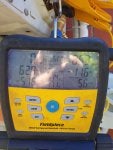This is a theory question. Everything here is in cooling mode and in metric units.
Some background: I've been helping my dad in the refrigeration/airconditioning domestic/commercial industry ever since I was little. Every time I was shown the liquid (thinner) line it was ice cold, whereas the suction (thicker) line was hot. When the system is low on gas the liquid line would form frost on its surface, my dad says to add gas to the system and watch as this frost moves up the liquid line and to the evaporator, once that frost reaches the evaporator that's when we know it has enough gas. My dad's old school, he doesn't use any digital stuff, it's all touchy/feely with him and he's had success that way for 30 years. Meanwhile I'm new to the trade, I've been installing/decommissioning independently for a year now, over 70 installs/removals so far this year. I want to be as knowledgeable and technological as possible in the HVAC industry. That's why I bought the Fieldpiece gauges and am using subcool/superheat to deduce information about the system. My dad has no idea what those terms mean. I want to learn every single thing about HVAC, as much as possible.
The system is a 2.5kW Panasonic Split System R410A for my bedroom. It is cooling well, the evaporator is blowing out air at around 8 degrees Celsius (infrared thermometer).
Problem: from my countless HVAC youtube videos and google image searches I've learned that subcooled liquid (3/4 liquid, 1/4 gas out of the RMD) (COLD!) goes into the evaporator, absorbs heat from the room, changes state to gas, then becomes superheated vapour before leaving and arriving at the suction line as superheated vapour (HOT!). The problem is seen in the attached photo of the Fieldpiece gauge.
![]()
Questions: So why is my Fieldpiece gauge showing a liquid line hotter than the suction line? Why is the subcool negative? Shouldn't the LLT (liquid line temperature) be COLDER than the saturation temperature of the refrigerant!? I connected the SLT (suction line temperature) to the suction line and the LLT to the liquid line at the outdoor unit.
Attempts at resolving: I tried asking my dad and brother (full HVAC license) and they said there's no problem at all, that the LLT is supposed to be higher than SLT, but that goes against eeeeeeverything I've watched and studied for so long. That makes no sense to me whatsoever. They weren't able to explain to me why in a way that I can understand.
How can a subcooled liquid be hotter than a superheated vapour?
Additional question: what kind of refrigerant metering device do residential split systems use? My dad says this AC uses a capillary in the indoor unit, but I thought it was a TXV in the outdoor unit?
Some background: I've been helping my dad in the refrigeration/airconditioning domestic/commercial industry ever since I was little. Every time I was shown the liquid (thinner) line it was ice cold, whereas the suction (thicker) line was hot. When the system is low on gas the liquid line would form frost on its surface, my dad says to add gas to the system and watch as this frost moves up the liquid line and to the evaporator, once that frost reaches the evaporator that's when we know it has enough gas. My dad's old school, he doesn't use any digital stuff, it's all touchy/feely with him and he's had success that way for 30 years. Meanwhile I'm new to the trade, I've been installing/decommissioning independently for a year now, over 70 installs/removals so far this year. I want to be as knowledgeable and technological as possible in the HVAC industry. That's why I bought the Fieldpiece gauges and am using subcool/superheat to deduce information about the system. My dad has no idea what those terms mean. I want to learn every single thing about HVAC, as much as possible.
The system is a 2.5kW Panasonic Split System R410A for my bedroom. It is cooling well, the evaporator is blowing out air at around 8 degrees Celsius (infrared thermometer).
Problem: from my countless HVAC youtube videos and google image searches I've learned that subcooled liquid (3/4 liquid, 1/4 gas out of the RMD) (COLD!) goes into the evaporator, absorbs heat from the room, changes state to gas, then becomes superheated vapour before leaving and arriving at the suction line as superheated vapour (HOT!). The problem is seen in the attached photo of the Fieldpiece gauge.

Questions: So why is my Fieldpiece gauge showing a liquid line hotter than the suction line? Why is the subcool negative? Shouldn't the LLT (liquid line temperature) be COLDER than the saturation temperature of the refrigerant!? I connected the SLT (suction line temperature) to the suction line and the LLT to the liquid line at the outdoor unit.
Attempts at resolving: I tried asking my dad and brother (full HVAC license) and they said there's no problem at all, that the LLT is supposed to be higher than SLT, but that goes against eeeeeeverything I've watched and studied for so long. That makes no sense to me whatsoever. They weren't able to explain to me why in a way that I can understand.
How can a subcooled liquid be hotter than a superheated vapour?
Additional question: what kind of refrigerant metering device do residential split systems use? My dad says this AC uses a capillary in the indoor unit, but I thought it was a TXV in the outdoor unit?





